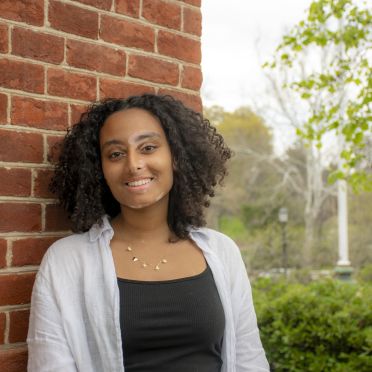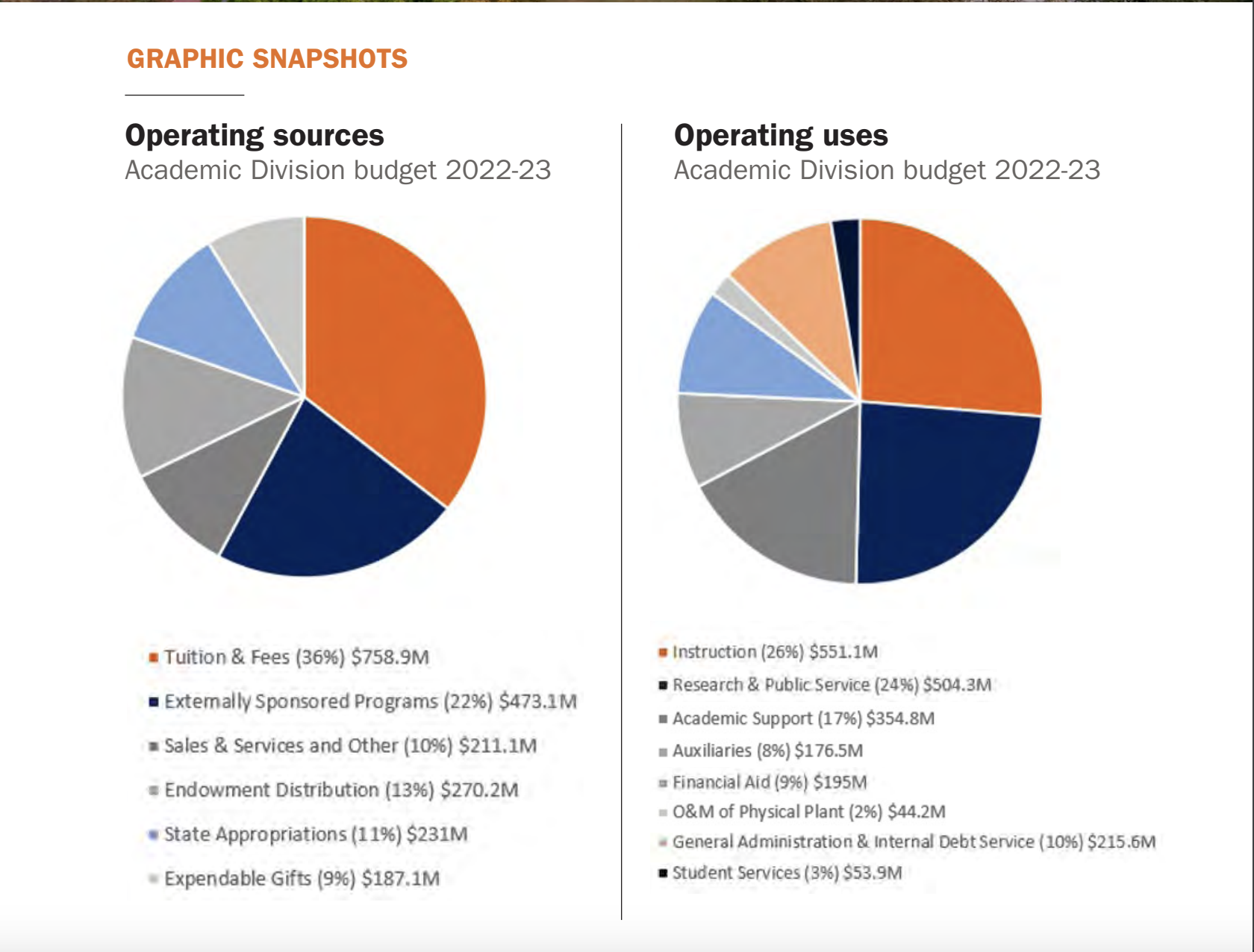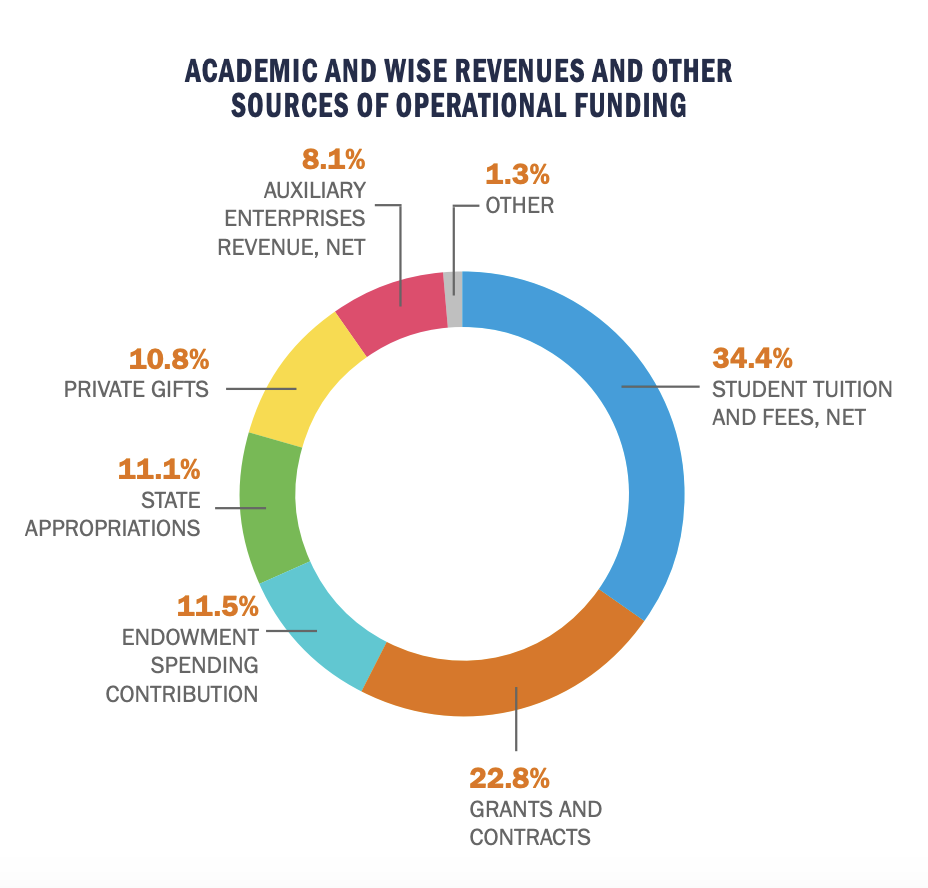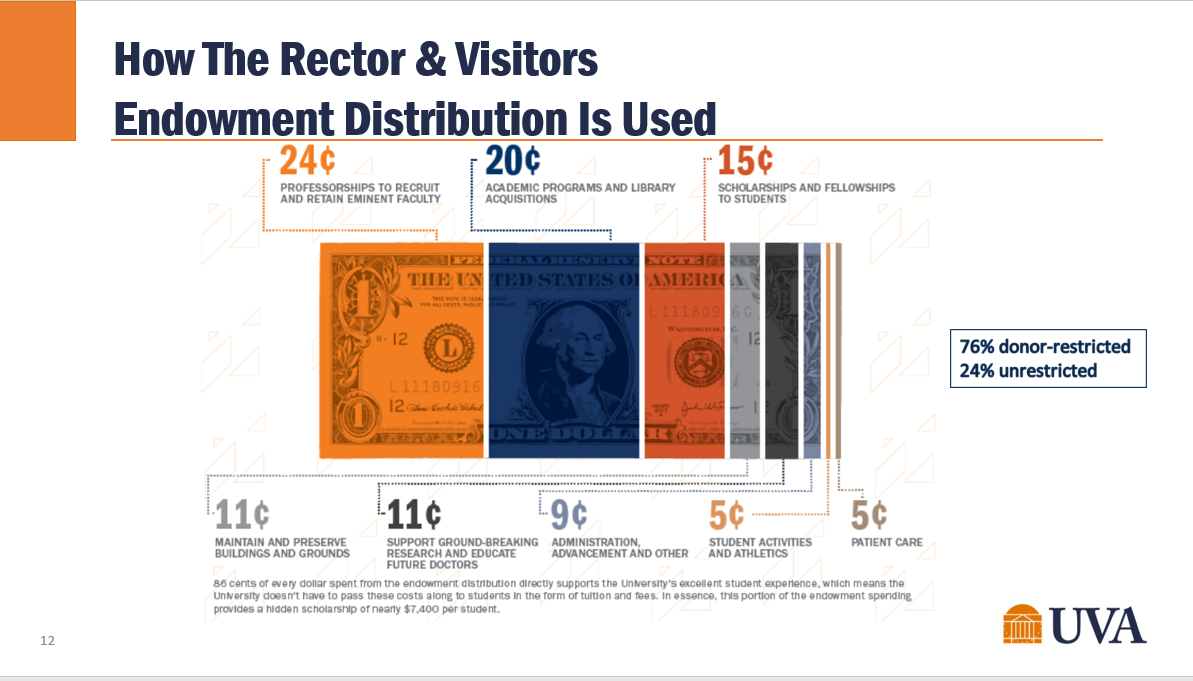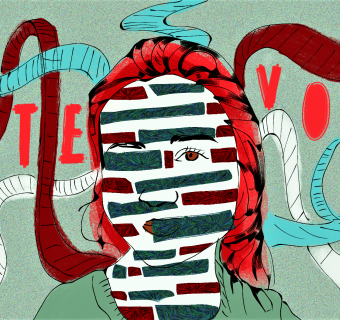Just over two weeks ago, I sat down (albeit over Zoom) for a conversation with University of Virginia’s Vice President for Finance, and Chief Financial Officer, Augie Maurelli, to talk about all things tuition for Iris Magazine.
My goal with this project was to contextualize where a student’s tuition money goes at UVA, and provide an insider’s view into the extent to which tuition plays a role in the University’s overall finances. An institution with the scale and scope as large as the University of Virginia takes a lot of people, energy, and of course, money, to keep fully operational.
For the 2022-2023 year, money generated from student tuition is the largest source of revenue for the University’s Academic Division budget, totalling at 36% or 578.9 million dollars, according to BOV Basics. This money from student tuition and fees, alongside other sources of funding goes towards instruction, research and public service, academic support, financial aid, and more. According to UVA’s financial report from 2021-2022, net tuition and fees made up more than one-third of the operating revenues for the Academic Division and Wise, which is the largest source of revenue, followed by grants and contracts. So, I think it’s safe to say that tuition is a critically important factor in how our university operates and functions.
Read on for more details about where your tuition and mandatory fees go, and Mr. Maruelli’s take on the subject. It’s okay if you’re shocked by the big numbers. I was too — sometimes as students we can forget just how big an enterprise the University of Virginia actually is.
This interview has been edited for length and clarity. Some important segments are bolded for emphasis.
Maurelli: So to start off, my name is Augie Maurelli. I'm the Vice President for Finance here at the University of Virginia as well as the chief financial officer. There are other chief financial officers, so the health system and Medical Center have one as well with separate reporting lines, so some of the areas that I oversee are enterprise wide, such as payroll, and some of the finance areas are academic division. So my entire portfolio would oversee what we call financial operations that would be procurement on the academic side, payroll on the enterprise-wide side, tax, treasury and risk management, which both oversee or overlap the Med Center and the academic division, financial reporting, as well as financial accounting for the academic division. So, it's interesting in that some of my duties are purely on the academic side, some cut across into the patient care realm as well.
Jiffar: Yeah, it's interesting and a bit interdisciplinary, so you'd have to juggle a lot of different perspectives.
Maurelli: And a lot of people might be unaware that the College of Wise, Rector and Visitors, and the Medical Center are all their own state agencies. But the Med Center and the Rector and Visitors reside under one tax ID. So some of the governance, some of the accounting treatments, some of the alignment is based on that structure. So separate state reporting, single federal reporting entity.
And, roughly speaking, if you look at our sources you've got tuition and fees, state appropriations, contracts and grants, and philanthropy.
Jiffar: I was just wondering if you could maybe give a rundown of what tuition is like, factored into the cost of the university. So I know tuition definitely isn't like the only source of funding for UVA. But I was just wondering to what extent tuition and mandatory fees are integral to covering operational costs for UVA such as maybe salaries or construction or something like that?
Maurelli: As you can see, student tuition, net of fees and scholarships, is $668 million and then another $443 million in sponsored activity. Now, you also have philanthropy $211 million in gifts. And, roughly speaking, if you look at our sources you've got tuition and fees, state appropriations, contracts and grants, and philanthropy. Those are the four big buckets and that averages out to be about 2 billion all in and that includes endowment distribution, as well. And then on the expenses, you've got the big ones compensation, salaries, benefits, supplies and other bin which is everything it takes to run the institution and then you've got student aid. There is 6.2% interest expense on our debt 4% and then Depreciation Amortization, which would be capital improvements and facility improvements, right. So the two big buckets on the expense side are paying salaries and providing benefits to our faculty and staff and then the operating expenses to keep the day to day going.
Jiffar: Speaking about grants and scholarships, I was wondering what you think about the importance of financial accessibility for students here, especially considering low income or first gen students, and do you think UVA is providing enough of the right resources and or do you think they could be doing any more?
Maurelli: So I know, it's a critical part of the 2030 Great and Good Strategic Plan. I'm a first generation college attendee. So absolutely, part of the reasons why I wanted to stay at UVA was that it was a phenomenal institution that can afford to provide opportunities, and also as a state entity needs to be affordable. And there is a fiscal opposition there of wanting to recruit and hire the best faculty, providing the best facilities, vs creating tremendous experiences. I mean, all those things do consume funds. But between the Bicentennial Scholars and Access UVA, I think we're one of only three state institutions that guarantee all need for all state attendees. Can you do more? Sure. I think there's always an insatiable need out there and it's being strategic in how we do it. Aligning our fundraising and our philanthropic efforts to make sure we're, matching and creating sustainable programs that will enable us to continue to provide those types of opportunities. I believe a fiscally sound enterprise that can be affordable and that can provide access is absolutely critical to the well being of our mission.
So, if the market is providing a windfall and you've got tremendous returns on your endowment, you might be able to manage through that in the short run.
Jiffar: Yeah, I totally agree. Thank you. And thinking about tuition in general, do you know about any reasons that the university would raise tuition and how that decision is reached?
Maurelli: Well, there's a lot. There's an article you can Google that just came out today in, I think, the Richmond Times-Dispatch. A lot of other schools in the Commonwealth don't have the application pool we have and they don't have some of the resources we have. And they're basically saying, last year, the governor asked all schools to hold their state tuition flat which we all honored. And VCU came back and said we can't afford it. We need to raise 6%. And, as I was going through that pie chart or those expenses when 67% of your expenses are people, and the state mandates a merit [pay] increase, you don't have a lot of levers. So, if the market is providing a windfall and you've got tremendous returns on your endowment, you might be able to manage through that in the short run. But more times than not tuition revenue and our salaries, percentage-wise, compare so if you're looking at a 3% cost of living adjustment across the board, you almost have to pull that tuition lever or maybe not to the full extent but it's a large source. It's not sustainable to hold that flat in perpetuity unless you're going to hold other things flat as well. And inflation has been problematic. If you look at the cost of food, it is a great example. Right? We had to increase our fees on the dining side because the food inflationary costs are through the roof right now.
Jiffar: Yes. And I was just wondering about the endowment, who controls the allocation of the endowment? And is the state involved in that?
Our endowment, we've got roughly 6.9 billion. It changes based on the market but let's call it $7 billion in donor-restricted endowment that resides with the Rector and Visitors.
Maurelli: No, so our endowment, we've got roughly 6.9 billion. It changes based on the market but let's call it $7 billion in donor-restricted endowment that resides with the Rector and Visitors. There are UAO's or university affiliated organizations that also have endowments whose mission is to support their respective school or aspects of the university that also sit in our endowment management entity or investment company. UVEMCO oversees the Rector and Visitors endowment. All of those gifts have gift agreements that are either partially restricted, fully restricted, or unrestricted based on the spend. The way endowments work is that those endowments get unitized and then the distributions get paid out to the school. Now the payout rate, and this is public as well, the Board of Visitors sets the payment strategy. So how it works is that our endowment distribution is pretty much set to raise with inflation. We take a three year Higher Education Price Index, it's called HEPI. It's similar to your CPI (consumer price index). And the three year average of HEPI is the increase we make to the distribution from the prior year. The caveat is it has to sit within a band of 3% to 5% of the total endowment. If that increase either broke the floor or the ceiling of that band, the board would have to come back and either reduce or increase the endowment to stay in that tunnel or make an exception. So you've got volatility protection on being pegged to a three year average of your price index. And then you've got guardrails from a market perspective and having to make that payment happen through the tunnel. Then that distribution gets sent out to all the owners. And they store those gifts accordingly.
Jiffar: That makes sense, thank you. I was wondering, also, how does the considerations of tuition play into the creation of the annual budget? Is that an important factor?
Maurelli: Yes, tuition is the largest aspect. On the academic side, tuition is our largest source. I think it's 63% of our sources.
Jiffar: And for my last question, is there anything else you would like students to know from your side, is there any misconception you would want to disprove about UVA finances?
Maurelli: I was going to ask you - I can tell you when I was an undergrad and even as a graduate student, if you look at the academic enterprise, you know $2 billion in activity, almost a half a billion and sponsored research, it's such a large enterprise that sometimes it's probably challenging to maintain perspective as to what it takes to run a university. And our COO JJ Davis and our provost, in my opinion, have incredibly difficult jobs, right? You've got to worry about public safety. You've got to worry about quality of facilities. You've got to make sure we're appropriately funding our programs to be successful. You've got to make sure we're providing access and affordability from an admissions perspective. And then while you're doing all that you have to be able to recruit and retain some of the best faculty on the planet. It truly takes a lot of effort and a lot of people to make that all happen. And I learn something new every day. I suppose I'd say if there's any misperception it's probably the scale and scope of an institution that size - it's probably difficult to appreciate the perspective holistically and positively.
Like every time I drive past that burned down hotel, I'm like, Oh, God, I can't wait to get an opportunity to buy that, do something with it, but until they're willing to sell it, our hands are tied.
Jiffar: Yes, because it's just so big.
Maurelli: Like if I'm an engineer (I was an engineering major), I had no idea what was going on at the College, right? You're so focused on your study of the field and what's impacting you. And sometimes not every school is seen on their strategic initiatives at the same time. So some of it's just timing. It does look different. I'd say the other thing is there are things we want to do today that we can't and it's not because we can't afford to. You've got city requirements, zoning requirements, federal requirements, sustainability issues. There's so many other tertiary impacts that maybe sometimes get dismissed. Like every time I drive past that burned down hotel, I'm like, Oh, God, I can't wait to get an opportunity to buy that, do something with it, but until they're willing to sell it, our hands are tied.
Jiffar: Yeah, that's interesting because one of my friends was saying UVA should just put that as dorms and that could solve current housing problems.
Maurelli: Tell your friend we're on the same page. I think half the university would love to see that structure go away, but unfortunately, we don't own it right now.
Jiffar: I guess a lot of different factors are at play that maybe a lot of people don't realize because they're also other entities that play a role in making this university go every day.
Maurelli: Yes, with the physical footprint, you definitely have a lot of other constituents that you need to deal with. And it can take a long time. Zoning, permitting, licensing, all of those things take time.
Jiffar: Great, thank you.


